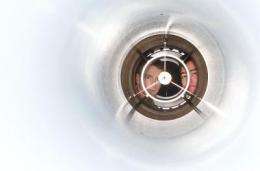Space shuttle experiment to provide insights into turbulence, heating

A Purdue University aerospace researcher helped shape plans to install a new experiment currently on the space shuttle Discovery to collect data for controlling deadly friction and heating in the design of future spacecraft.
Discovery was launched March 15 on a 13-day mission.
A special "roughness element" was installed among the shuttle's heat-shielding panels. The element is raised about a quarter of an inch and will be used to study how air turns from "laminar," or smooth, to turbulent. Data from the research will help design the heat shield for NASA's Orion crew exploration vehicle, a vital component in future missions to the moon and Mars.
Data from the experiment also will help engineers design "hypersonic" aircraft that travel faster than Mach 5, nearly 4,000 mph, said Steven Schneider, a professor in Purdue's School of Aeronautics and Astronautics.
The faster an aircraft flies, the greater the friction and dangerous heating. Such heating damaged the leading edge of the heat-shielding system on the space shuttle Columbia, causing it to burn up as it entered the atmosphere in 2003.
"We have been arguing in favor of doing some sort of space shuttle flight experiment, and after the Columbia accident there was a lot more attention paid to aero heating," said Schneider, who aided NASA in planning the experiment.
Data will be collected while the shuttle re-enters the Earth's atmosphere at the conclusion of the mission. The landing is scheduled for Saturday (March 28).
A better understanding of the transition from smooth to turbulent airflow is critical to the design of spacecraft and hypersonic aircraft and engines called scramjets, or supersonic combustion ramjets.
Purdue researchers also are using the only wind tunnel capable of running quietly at hypersonic speeds and have conducted experiments to yield data for designing advanced missiles such as the Falcon HTV-2 and an advanced aircraft called the X-51A, which is powered by scramjets. The X-51 project is led by the Air Force Research Laboratory and the Defense Advanced Research Projects Agency.
The experiment on Discovery, which also is planned for two additional shuttle missions, will complement wind tunnel experiments and findings from computational models.
"It is very desirable to conduct an experiment like this under real flight conditions on a real shuttle instead of a model," Schneider said. "But no single experiment, whether on the ground or in flight, can give you everything you want."
Air flowing over a hypersonic vehicle should generally be as smooth as possible to reduce friction and heating, which increases drag and necessitates a heavier thermal protection system for the vehicle's thin metal skin.
At the same time, researchers also need to learn how to create turbulent airflow to operate the scramjet engines. Scramjet designs use a scooplike cowl on the underbelly, where air rushes into the inlet of the engine's combustor. It is critical for air entering the inlet to be turbulent at hypersonic speeds, or the engine could "unstart," causing it to crash, Schneider said.
For this reason, air has to be converted to a turbulent flow before entering the inlet. This conversion is accomplished using a raised strip of metal placed near the inlet to "trip" the air from smooth to turbulent. Wind tunnel tests are helping engineers better understand this "roughness-induced transition."
Purdue researchers are using a roughness element inside the wind tunnel to study the airflow transition. Detailed wind tunnel measurements are to aid other researchers who are developing computational models capable of simulating the shuttle experiment.
The quiet wind tunnel operation is critical for collecting data to show precisely how air flows over a vehicle's surface in flight. No other wind tunnel runs quietly while conducting experiments in airstreams traveling at Mach 6, Schneider said.
Source: Purdue University (news : web)















